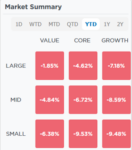Ask economists how they forecast economic activity. It’s likely they will mention productivity, demographics, debt, the Fed, interest rates, and a litany of other elements. Economic confidence is probably not at the top of the list for most economists. It is tricky to gauge as it can be inconsistent. However, confidence can sometimes change quickly and often with significant economic impacts.
Look at the two pictures below. Can you spot a difference between them?
The difference is subtle. The restaurant on the left has 54 diners. While the one on the right is missing the three diners in the front.
What if the three missing diners decided to eat at home that day due to waning confidence in the economy and, ultimately, concerns about the safety of their jobs and investments?
Read More »

















































